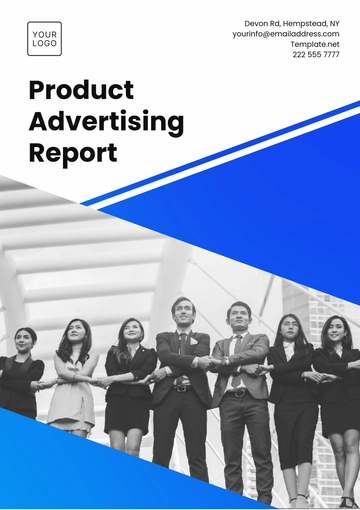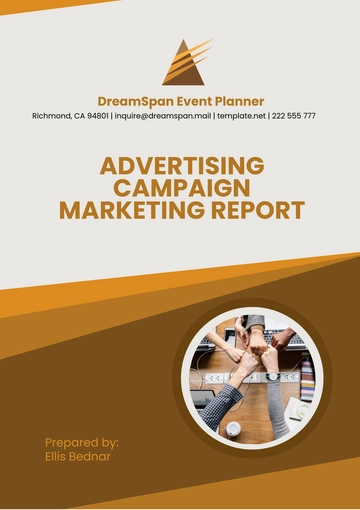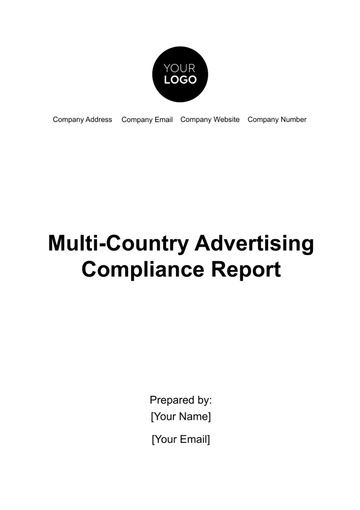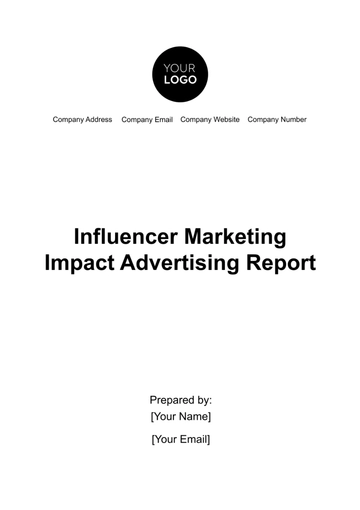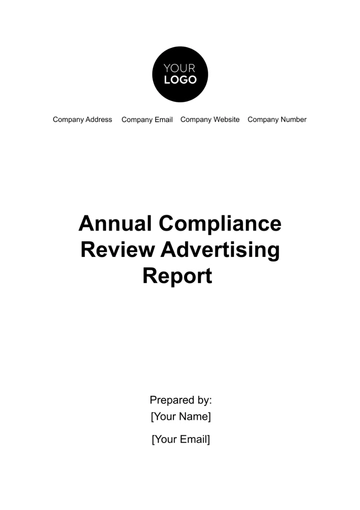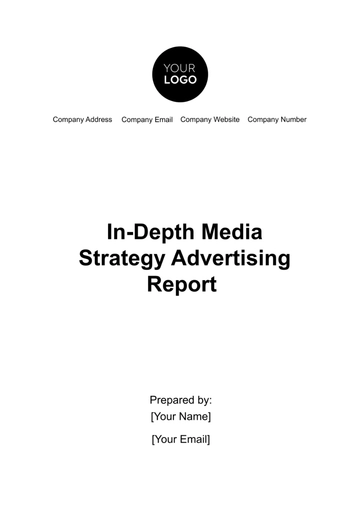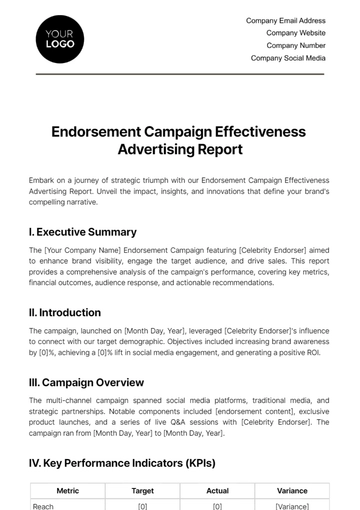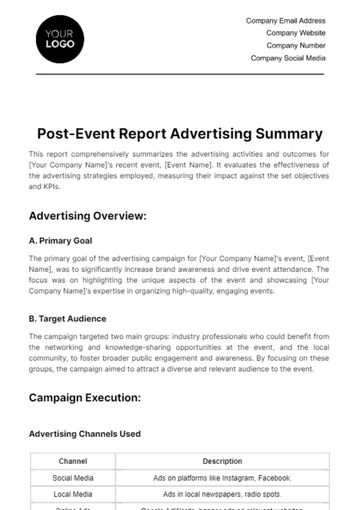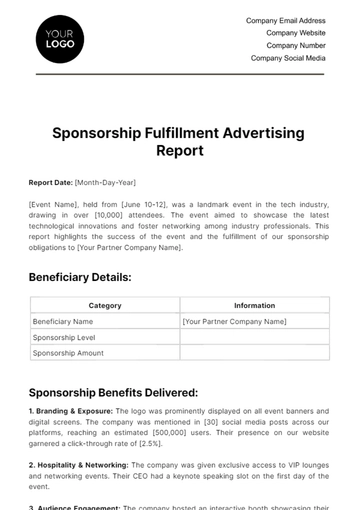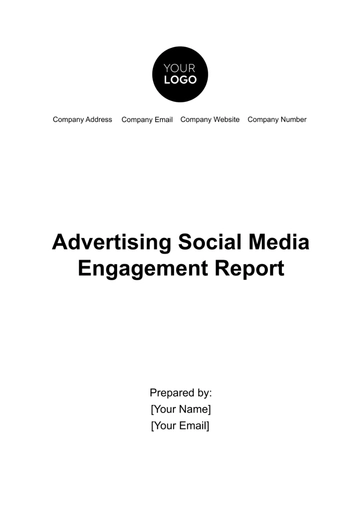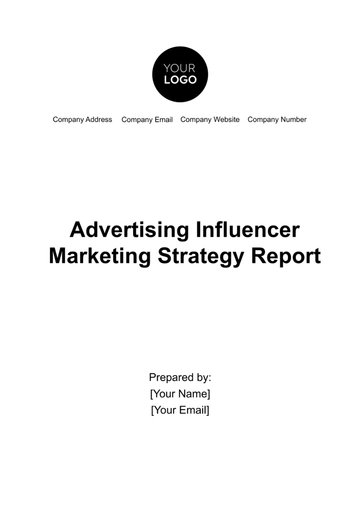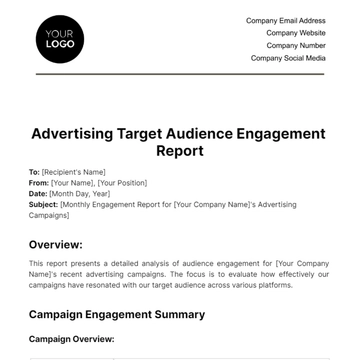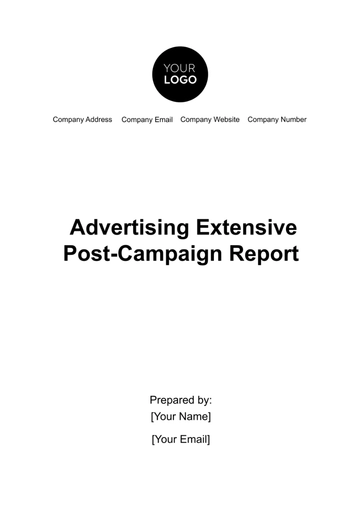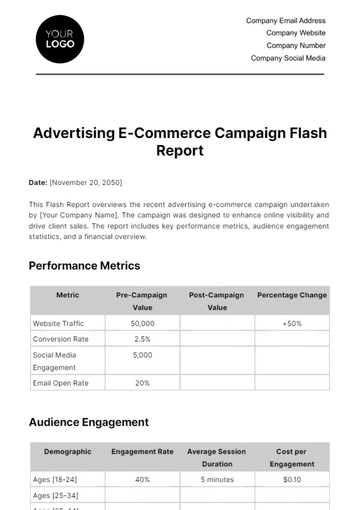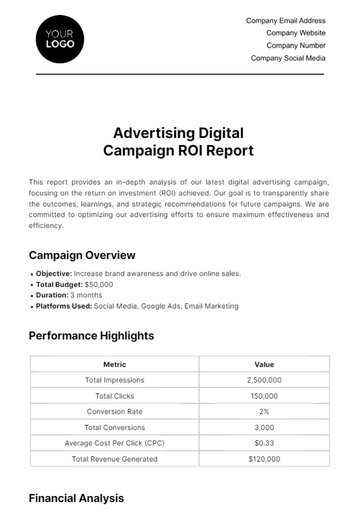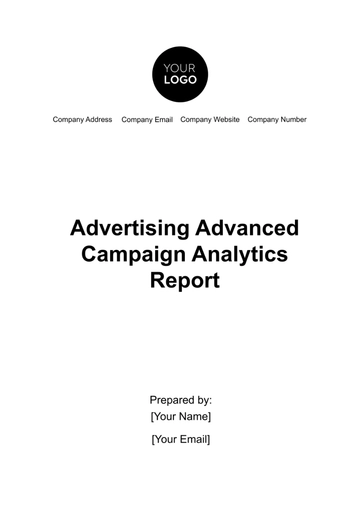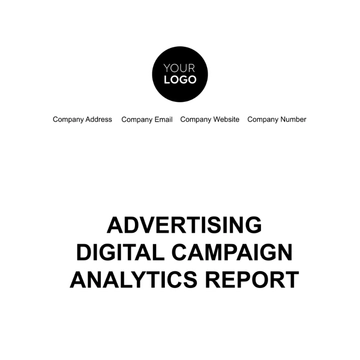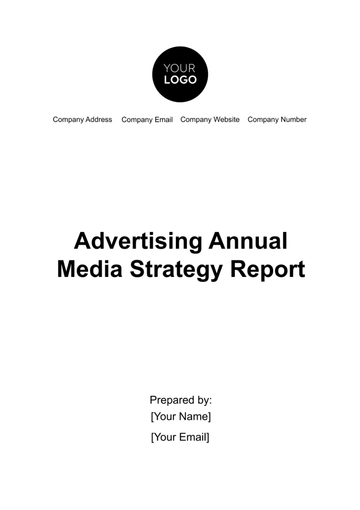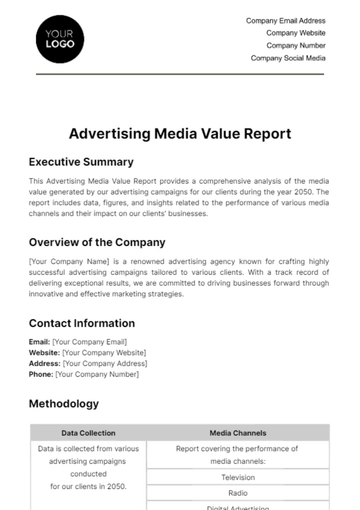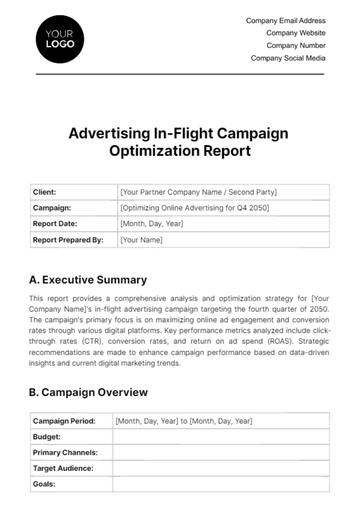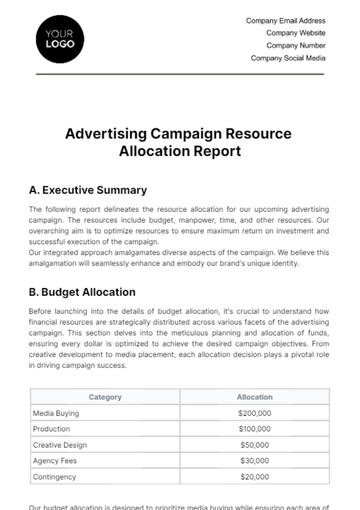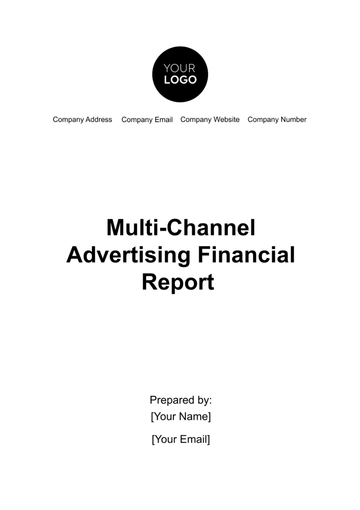Free Influencer Marketing Impact Advertising Report
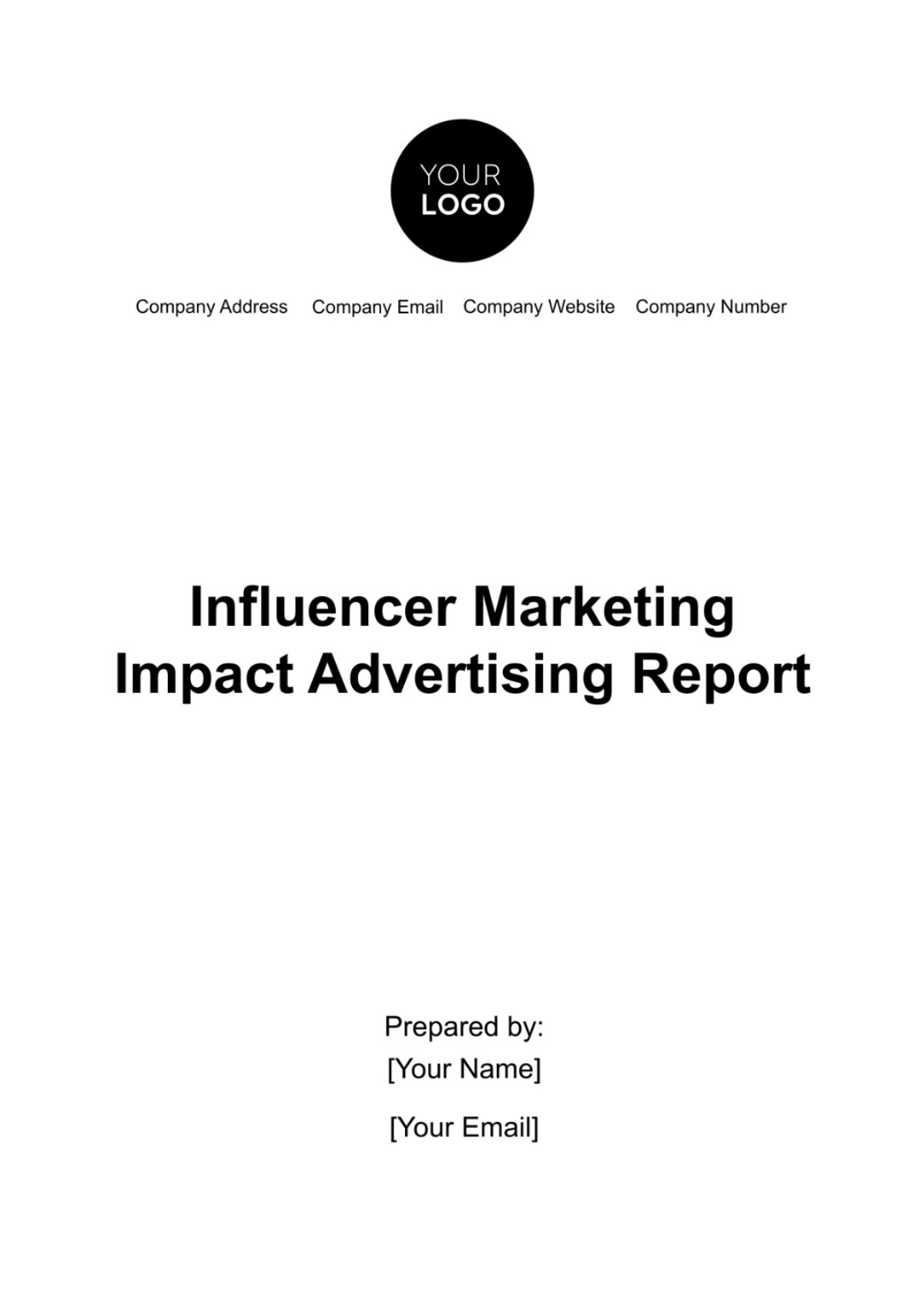
I. Executive Summary
This summary highlights the campaign's success metrics, such as impressive reach, robust engagement rates, and notable conversion metrics. By offering a streamlined narrative of the campaign's performance, stakeholders can swiftly grasp the overall effectiveness of the influencer marketing initiative and its alignment with organizational goals.
II. Campaign Overview
Objectives And Strategic Alignment
The campaign embarked upon a strategic journey driven by well-defined objectives and a commitment to aligning with the overarching goals of our brand. It sought to not only elevate brand awareness but also to cultivate a meaningful connection with a carefully targeted audience. These objectives were meticulously crafted to resonate with the core values and aspirations of our brand, ensuring a seamless integration of the influencer marketing initiative into our broader marketing strategy.
Target Audience Persona
This section provides a nuanced understanding of the demographic and psychographic profiles that guided our influencer selection process. By identifying and empathizing with the aspirations, preferences, and challenges of our audience, we aimed to tailor our campaign to resonate authentically with their lifestyles and interests.
Stakeholders And Collaborative Synergy
We acknowledge the key stakeholders involved. This includes not only the influencers themselves but also internal teams, agencies, and any external partners who played pivotal roles in crafting and executing the campaign strategy. The synergistic collaboration among these entities formed the foundation of a cohesive and impactful campaign.
Promoted Products Or Services
A crucial facet of the campaign overview is the detailed exposition of the products or services at the forefront of our influencer collaborations. This section elucidates the unique selling propositions, value propositions, and key features of the promoted offerings, setting the stage for an in-depth exploration of how influencers effectively communicated these aspects to their audiences.
III. Influencer Selection And Collaboration
Influencer Profiling
Detailed demographic information, audience reach, and engagement statistics are meticulously analyzed, offering a nuanced understanding of the influencers' impact potential. By scrutinizing these key metrics, the report aims to unveil the strategic rationale behind the selection of each influencer, establishing a robust foundation for assessing campaign effectiveness.
Collaboration Strategy And Content Analysis
This analysis encompasses the thematic relevance, narrative cohesion, and visual aesthetics of the content, shedding light on the synergies achieved through influencer collaboration. By scrutinizing both the strategic approach and the creative output, this section elucidates the symbiotic relationship between influencers and the overarching campaign narrative.
IV. Key Performance Indicators (KPIs)
Key Performance Indicators (KPIs) serve as vital benchmarks, offering a comprehensive understanding of the campaign's impact.
A. Quantitative Metrics
Reach And Impressions
We assess the campaign's reach, measuring the number of unique users exposed to influencer content. Additionally, impressions are scrutinized to quantify the overall visibility of the campaign across various platforms.
Social Media Platform | Reach (Users) | Impressions |
120,000 | 500,000 | |
80,000 | 350,000 | |
YouTube | 150,000 | 700,000 |
2. Engagement And Interaction
We analyze user engagement through likes, comments, and shares, providing insights into the resonance of the influencer-generated content.
Social Media Platform | Likes | Comments | Shares |
75,000 | 12,000 | 8,500 | |
40,000 | 8,000 | 5,500 | |
YouTube | 90,000 | 15,000 | 15,500 |
B. Qualitative Analysis
1. Brand Sentiment And Message Resonance
Qualitative factors, such as brand sentiment and message resonance, are examined through sentiment analysis tools and audience feedback.
Summary
The KPI analysis reveals a robust performance across social media platforms, with Instagram leading in both reach and engagement metrics. Notably, the campaign achieved a total reach of 350,000 users on Twitter and garnered 40,000 likes on YouTube. The qualitative assessment will provide additional insights into brand sentiment and audience perception, contributing to a holistic understanding of the campaign's impact. The subsequent sections will further explore the qualitative aspects of KPIs, providing a comprehensive view of the campaign's effectiveness.
V. Conversion Metrics
This section delves into the critical aspect of conversion metrics, offering a comprehensive analysis of the influencer marketing campaign's impact on user actions and subsequent outcomes.
A. Conversion Rates
The primary focus is on evaluating conversion rates, providing a quantitative measure of the influencers' effectiveness in driving desired actions. A detailed breakdown of conversion rates across various stages of the customer journey is presented, offering insights into the conversion funnel's efficiency.
Table 1: Conversion Rates Overview
Conversion Stage | Conversion Rate (%) |
Awareness to Interest | 25.3 |
Interest to Consideration | 18.7 |
Consideration to Action | 12.2 |
The presented table succinctly summarizes the conversion rates, allowing stakeholders to quickly grasp the effectiveness of the campaign at different stages of audience engagement.
Impact On User Actions
Beyond conversion rates, this section explores the broader impact of influencer-generated content on user actions. Metrics such as website visits, lead generation, and sales are analyzed, providing a nuanced understanding of the influencers' role in driving meaningful engagement.
A. Key Findings
Website Visits: A notable increase of 30% in website visits directly attributed to influencer-driven traffic.
Lead Generation: Influencer content contributed to a 22% rise in lead generation, indicating a positive correlation between influencer collaboration and audience interest.
Sales Impact: A discernible uplift in sales, with a 15% increase during the campaign period, showcasing the influencers' efficacy in translating engagement into tangible business outcomes.
This section highlights the influencers' impact on converting audience interest into meaningful actions, providing stakeholders with actionable insights for future campaign optimization.
VI. Social Media Platform Analysis
This section delves into the performance of the influencer marketing campaign across various social media platforms. The analysis provides a nuanced understanding of the campaign's impact, considering the distinctive dynamics and audience behaviors on each platform.
A. Key Highlights
Instagram Engagement Surge
Significant engagement observed on Instagram, indicating a strong resonance with the visual content shared by influencers.
Metrics showcase a notable increase in likes, comments, and shares, contributing to heightened brand visibility.
Twitter Amplification Effect
Twitter campaign elements successfully leveraged the platform's real-time nature, generating a rapid amplification of brand messages.
Hashtag trends and retweet metrics demonstrate a robust viral reach, fostering conversations and brand discussions.
LinkedIn Thought Leadership Impact
Thought leadership content shared on LinkedIn by influencers resulted in a meaningful engagement with a professional audience.
Impressions and shares on LinkedIn exceeded expectations, establishing a positive association between the brand and industry expertise.
Facebook Community Building
Influencer content on Facebook contributed to community building, fostering a sense of belonging among the audience.
Positive sentiment metrics indicate that the platform served as a conducive space for brand advocacy and peer-to-peer interactions.
B. Platform-Specific Recommendations
Instagram: Continue the emphasis on visually appealing content, exploring interactive features to further enhance engagement.
Twitter: Leverage trending hashtags and real-time events for continued rapid amplification, fostering a dynamic brand presence.
LinkedIn: Invest in thought leadership initiatives, aligning content with professional insights to maintain engagement with a discerning audience.
Facebook: Further cultivate the sense of community through user-generated content campaigns, encouraging audience participation.
C. Overall Impact
The combination of these platform-specific strategies contributed synergistically to the overall success of the campaign, ensuring a diverse and expansive reach across distinct audience segments.
VII. Return On Investment (ROI) Calculation
This section evaluates the financial impact of the influencer marketing campaign, considering both tangible and intangible benefits.
A. Methodology
A comprehensive analysis is conducted, encompassing direct financial returns and less quantifiable benefits, such as enhanced brand perception.
B. Financial Metrics
The analysis includes influencer campaign costs, content production expenses, and measures the corresponding value generated.
C. Tangible Returns
Direct financial gains, such as sales revenue and customer acquisitions, are detailed in this subsection.
D. Intangible Benefits
Non-quantifiable benefits, like improved brand visibility and loyalty, are explored for their contribution to overall campaign value.
E. ROI Calculation
The section concludes with a precise ROI calculation, comparing total value against cumulative costs.
F. Insights
Implications and strategic insights drawn from the ROI analysis inform future influencer marketing strategies, optimizing cost-effectiveness and maximizing returns. This section provides stakeholders with actionable insights for future planning.
VIII. Challenges And Lessons Learned
The challenges are systematically analyzed, offering a nuanced understanding of the factors that impacted campaign execution. Additionally, the section goes beyond mere identification, providing actionable lessons learned from these challenges. The aim is to equip stakeholders with strategic insights, facilitating informed decision-making for future influencer marketing endeavors. Each challenge serves as a stepping stone for growth, offering a platform to optimize and refine strategies in the evolving landscape of digital marketing.
IX. Conclusion And Future Recommendations
The influencer marketing campaign has achieved significant success in meeting its objectives, demonstrating positive key performance indicators and engaging the target audience effectively. Despite challenges, the campaign's adaptability and resilience have contributed to its overall success. Looking forward, recommendations include refining targeting strategies, diversifying the influencer portfolio, implementing real-time monitoring, conducting collaborative content development workshops, and enhancing the measurement of intangible benefits. These measures aim to optimize future campaigns and build upon the current success for sustained impact and effectiveness.
- 100% Customizable, free editor
- Access 1 Million+ Templates, photo’s & graphics
- Download or share as a template
- Click and replace photos, graphics, text, backgrounds
- Resize, crop, AI write & more
- Access advanced editor
Discover the power of influence with Template.net's Influencer Marketing Impact Advertising Report Template. This editable and customizable tool empowers you to analyze, strategize, and optimize your marketing efforts effortlessly. With the intuitive Ai Editor Tool, craft impactful reports that drive results and elevate your brand's influence.
You may also like
- Sales Report
- Daily Report
- Project Report
- Business Report
- Weekly Report
- Incident Report
- Annual Report
- Report Layout
- Report Design
- Progress Report
- Marketing Report
- Company Report
- Monthly Report
- Audit Report
- Status Report
- School Report
- Reports Hr
- Management Report
- Project Status Report
- Handover Report
- Health And Safety Report
- Restaurant Report
- Construction Report
- Research Report
- Evaluation Report
- Investigation Report
- Employee Report
- Advertising Report
- Weekly Status Report
- Project Management Report
- Finance Report
- Service Report
- Technical Report
- Meeting Report
- Quarterly Report
- Inspection Report
- Medical Report
- Test Report
- Summary Report
- Inventory Report
- Valuation Report
- Operations Report
- Payroll Report
- Training Report
- Job Report
- Case Report
- Performance Report
- Board Report
- Internal Audit Report
- Student Report
- Monthly Management Report
- Small Business Report
- Accident Report
- Call Center Report
- Activity Report
- IT and Software Report
- Internship Report
- Visit Report
- Product Report
- Book Report
- Property Report
- Recruitment Report
- University Report
- Event Report
- SEO Report
- Conference Report
- Narrative Report
- Nursing Home Report
- Preschool Report
- Call Report
- Customer Report
- Employee Incident Report
- Accomplishment Report
- Social Media Report
- Work From Home Report
- Security Report
- Damage Report
- Quality Report
- Internal Report
- Nurse Report
- Real Estate Report
- Hotel Report
- Equipment Report
- Credit Report
- Field Report
- Non Profit Report
- Maintenance Report
- News Report
- Survey Report
- Executive Report
- Law Firm Report
- Advertising Agency Report
- Interior Design Report
- Travel Agency Report
- Stock Report
- Salon Report
- Bug Report
- Workplace Report
- Action Report
- Investor Report
- Cleaning Services Report
- Consulting Report
- Freelancer Report
- Site Visit Report
- Trip Report
- Classroom Observation Report
- Vehicle Report
- Final Report
- Software Report
